|
Frank Goldsborough landed once at Tucson, Friday, May 2, 1930 at 10:45AM. He was solo in the Kinner-powered Fleet 2, NR406K, S/N 129. Based at Westfield, NJ, he arrived at Tucson from El Paso, TX. He identified his destination as Los Angeles, CA. He remained on the ground for a half hour, departing westbound at 11:15AM. Photograph, left, is from the Chester Times (PA), July 17, 1930. The complete article is below.
Goldsborough was born July 16, 1910 in Washington, DC. He was one of the youngest pilots to sign the Tucson Register. The 1920 U.S. Census (his first) placed him at age 9 living as a boarder with the Thompson family in Queens, NY. The photograph, left, is from findagrave.com.
The only other photograph I have of him is below, courtesy of the San Diego Aerospace Museum (SDAM). It was snapped in front of the Russell Parachute Company, probably at 1202 Kettner Avenue (Blvd.?) in San Diego, CA. It is inscribed "To My Friend Fanney" (Finney?) and signed by "American Boy" Goldsborough. The link is a PDF download (281Kb) that summarizes the Russell Parachute Company business.
Frank H. Goldborough (L) & "Fanney," Ca. 1930 (Source: SDAM)
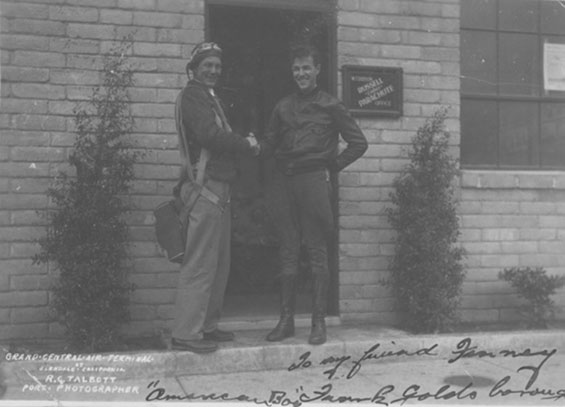 |
Goldsborough's parachute pack looks like it could be one of Russell's "lobe" parachutes as pictured in the PDF. Note the light trim edges on the pack.
Goldsborough cited no purpose for his visit at Tucson, but with a little research we know why he was there. At 19 years old, he was westbound on a transcontinental flight for an official junior record. The previous record was 48 hours. He beat that when he reached Los Angeles setting a new record for east to west flight time of 34 hours, 3 minutes. His success was summarized by The New York Times (NYT) of May 5, 1930, below.
The New York Times, May 5, 1930 (Source: NYT)
 |
Given that the article says he had learned to fly only the previous September, he did very well in dealing with weather conditions, airplane repairs and navigating, all the while solo in a light airplane. The 1930 Census, dated April 2nd, about a month before we find him at Tucson, corroborates his committment to aviation. At age 19, he lived in Queens, NY with his stepmother and both grandmothers. His occupation was listed as "Aviator" operating as a "Private Aviator."
His track across the U.S. in 1930 was relatively easy to monitor. Like the summary above, a number of articles under his byline were commissioned and published by The New York Times. They followed him from New York to Columbus, OH, to St. Louis and Tulsa, OK, Midland and El Paso, TX and on to Los Angeles, CA where he landed at the Grand Central Air Terminal in Glendale, CA. His signature did not show up in the Glendale Register because the first entry in that Register was December 14, 1930, seven months after he landed there.
The New York Times, May 4, 1930 (Source: NYT)
 |
The Times of May 4, 1930, right, placed him at both El Paso and Tucson. Leaving El Paso at 7:05AM and landing at Tucson at 10:45 was excellent time back then with a Fleet aircraft. From the article, his trip from El Paso to Tucson was the easy leg. He ran into bad weather as he went west toward Yuma, AZ and was forced to take two days to get to Los Angeles.
He wrote a summary for his eastbound flights, too. It appeared in The Times of May 12, 1930, below. His eastbound time was 28 hours and 18 minutes, again a record.
The New York TImes, May 12, 1930 (Source: NYT)
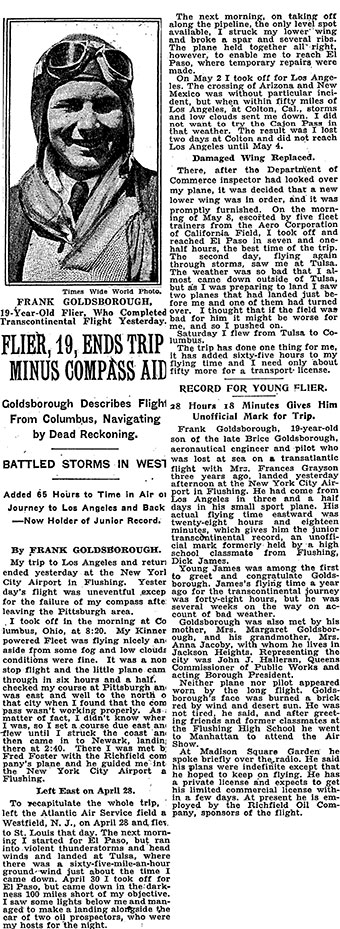 |
As was usual in the world of Golden Age air records, Goldsborough's record was soon eclipsed in the same year and the record time was reduced to 29 hours and 41 minutes in August. It was fellow Register pilot Eddie Schneider who set the lower record on August 19, 1930, below.
E. Schneider's New Record, The New York Times, August 19, 1930 (Source: NYT)
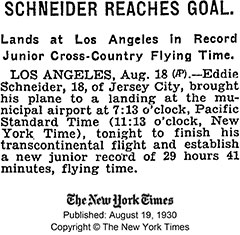 |
In September, 1930, another Register pilot competed for the junior title. Robert Buck attempted his record at the age of 16. Similar to Goldsborough, he had been flying only eight months and had accumulated 150 flight hours as he took off cross-country from Newark, NJ. Buck flew the Pitcairn PA-5S NC549K, S/N 49. Photographs of Buck and 549K are at their respective links.
Buck improved upon Goldsborough's record in his westbound flight to California with 28 hours
elapsed flying time. This was also an hour and 40 minutes faster than the
current record.
He improved upon Goldsborough's eastbound record, too, traveling from Los Angeles to Newark, NJ in 23 hours 47 minutes
elapsed flight time.
But Goldsborough was never to be bothered by the loss of any of his hard-earned trans-continental records. He spent the next several weeks after his flights in western New York while alterations were made to his airplane by the Consolidated Aircraft Corporation, manufacturers of the Fleet line of biplanes.
On the morning of July 14, 1930, Goldsborough and a friend and newspaper reporter, Donald Mockler, left Cleveland, OH (some news sources state that he flew from Buffalo, NY) to fly to Keene, NH where Goldsborough was to give a lecture about his cross-country exploits. They stopped at Schenectady, NY on the way.
The New York Times of July 15th bore the headline, "Goldsborough Crashes on Vermont Mountain; Party Seeks Young Flier Pinned Under Plane." He had crashed into a peak in the Green Mountains eight miles east of Bennington, VT in what was described as low clouds and low visibility. The Times article is below.
The New York Times, July 15, 1930 (Source: NYT)
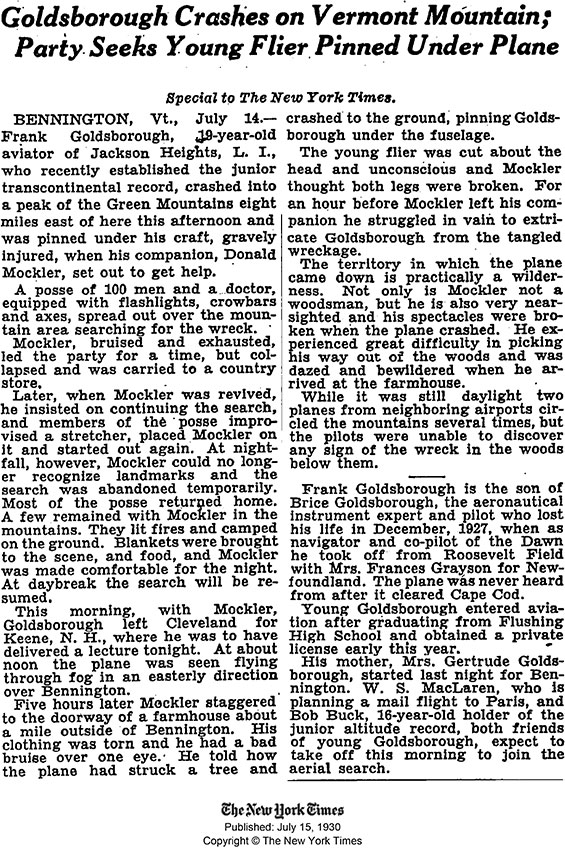 |
The stalwart Mockler, while injured, tried to extricate Goldsborough from the wreckage to no avail. He finally made it out of the woods to summon aid. That took him about five hours. All totaled, Goldsborough lay in the woods about 18 hours before help came to him. He was still alive, but unconscious by the time he was found by a search party led by Mockler. Note, above, that Goldsborough's junior record colleague Bob Buck and Register pilot Wiliam S. Maclaren were part of the aerial search party. The final details of the crash, the search, and Goldsborough's demise were published in The Times of July 17th, below.
The New York Times, July 17, 1930 (Source: NYT)
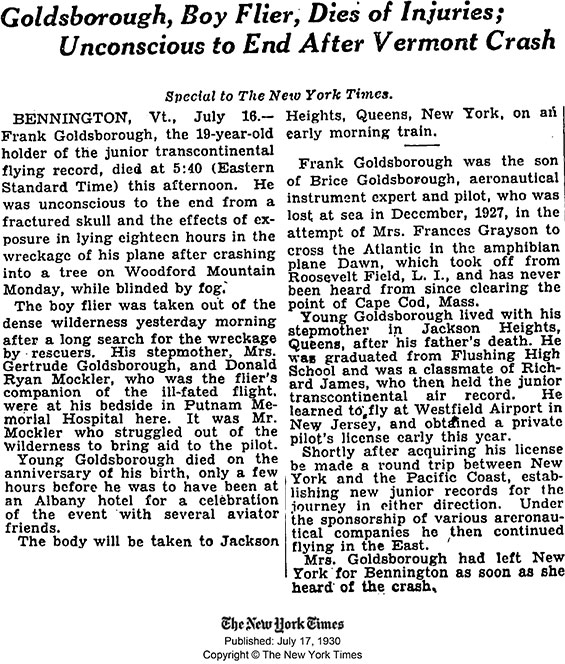 |
The New York Times, July 18, 1939 (Source: NYT)
 |
Follow-on articles were published by The Times and other newspapers. One, right, from July 18th, described a premonition stated by Goldsborough to one of his acquaintences. Goldsborough had a small dog named Contact that he left behind with a friend, the president of the local Kiwanis Club, stating, "Keep Contact for me, will you? I've got a feeling something is going to happen."
The Dallas Morning News (TX) of July 15, 1930 reported the accident as follows.
Record Flyer, Hurt in Plane, Being Sought.
Comrade Leaves Goldsboro, Alive in Wreck, to Seek Aid.
BENNINGTON, Vt., July 14. (AP).---Frank Goldsboro, 19, holder of the junior transcontinental flight record, was pinned beneath the wreckage of his plane in the woods near here Monday. Donald Mockler, a companion, made his way from the plane wreckage to Bennington, but was unable exactly to locate the position where they had crashed.
Goldsboro and Mockler left the Buffalo, N. Y., airport in the morning. Mockler reported the plane crashed into a tree in the wooded mountain lands west of Bennington at about noon.
Mockler, footsore and suffering exposure and minor injuries, said he had made his way to the town after he had been unable to extricate Goldsboro from the plane wreckage. Goldsboro was still alive when Mockler left for help.
For five hours Mockler wandered in the woods, finally making his way to a farmhouse, where he was given transportation to Bennington.
An hour later, a posse of rescuers, accompanied by a doctor, nurse and ambulance, had left Bennington for the woodlands. Mockler could not say exactly where the plane had crashed but believed that he traveled about fifty miles before reaching the farmhouse. |
The Chester Times (PA) for July 17, 1930 reported the accident, below.
BOY FLIER DIES OF CRASH INJURY.
GOLDSBOROUGH RECORD HOLDER, SUCCUMBS AS MOTHER HURRIES TO SIDE.
Bennington, Vt., July 17 -- The body of FRANK GOLDSBOROUGH, young aviator whose flight mishap is similar in many ways to that which resulted in the death of his father three years ago, was taken from here to Albany, N.Y., today in the hearse of a local undertaker. Later, the body was to be taken by train to New York.
The 19-year-old pilot did not regain consciousness after lying insensible in the wreckage of his plane for 18 hours after it crashed into Woodford Mountain Tuesday.
He grew weaker through yesterday and his stepmother, MRS. GERTRUDE GOLDSBOROUGH, of Jackson Heights, L. I., was notified. She arrived at his bedside a few minutes after he died.
Young GOLDSBOROUGH and DONALD MOCKLER ran into dense fog over the Woodford Mountain, near here. They tried to dive under it but plunged to the ground, pinning GOLDSBOROUGH under the wreckage.
MOCKLER, crawling free, tried vainly to free the pilot. Then he set out through the wilderness of woods and swamp to get help.
Tuesday at daybreak, a mountaineer and hunter led five companions to the stricken youth. With greatest difficulty he was brought to the Putnam Memorial Hospital here where the end came.
|
It is mentioned in a couple of the articles above that Frank Goldsborough was the son of Brice Goldsborough (not a Register pilot), who flew as navigator for Walter Beech during the 1926 (the 2nd) Ford Reliability Tour. Brice was a founder in 1919 and the president of the Pioneer Instrument Company, which manufactured high-quality navigational instruments for aviation applications. The elder Goldsborough died in a plane crash in the Atlantic Ocean in December, 1927 in a trans-Atlantic flight attempt.
The New York Times, July 16, 1930 (Source: NYT)
 |
On July 16, 1930, The New York Times reported Mockler's side of the story, right. Mockler's testimony occurred before Goldsborough was found and moved to a hospital. His Vermont death certificate is below, courtesy of ancestry.com.
Frank H. Goldsborough, Vermont Death Certificate, July 16, 1930 (Source: ancestry.com)
 |
Over a year after his death, Goldsborough's estate was appraised and valued at $41,086 as reported in The Times for September 10, 1931, below. The 1931 buying power of that amount of money as of the upload date of this page would be over $600,000 today.
The New York Times, September 10, 1931 (Source: NYT)
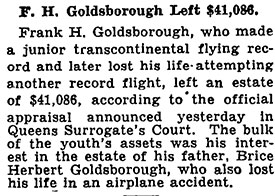 |
Frank H. Goldsborough joined the ranks of Golden Age aviators who died too young (see, for example, George Faw). Goldsborough's crash occurred a day before his 20th birthday, and he died a day later on the evening of that anniversary.
---o0o---
THIS PAGE UPLOADED: 07/15/16 REVISED:
|













